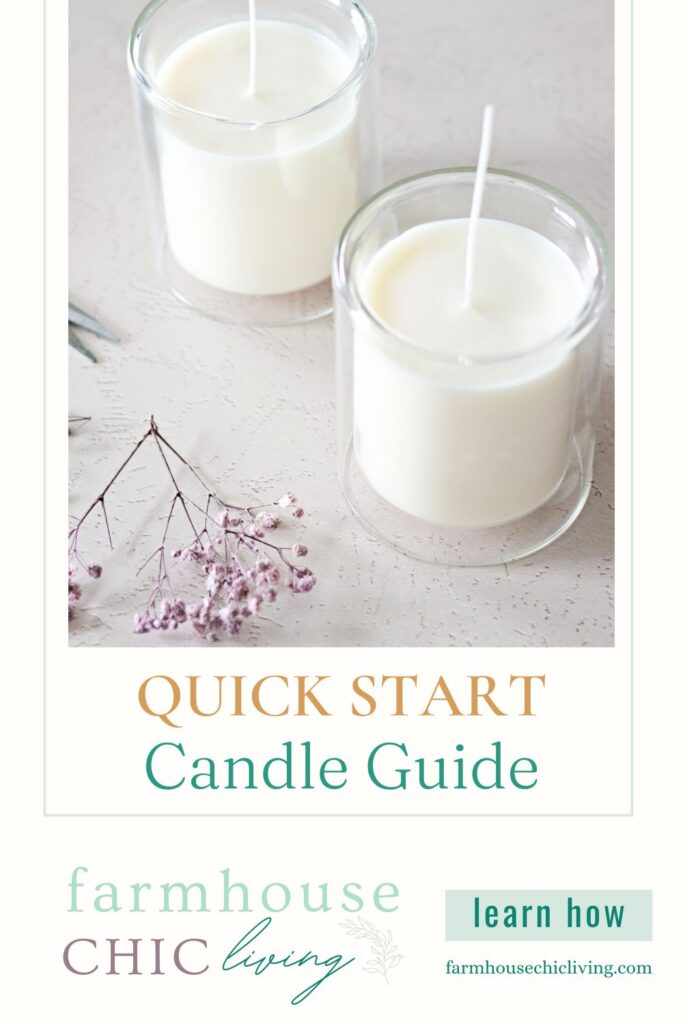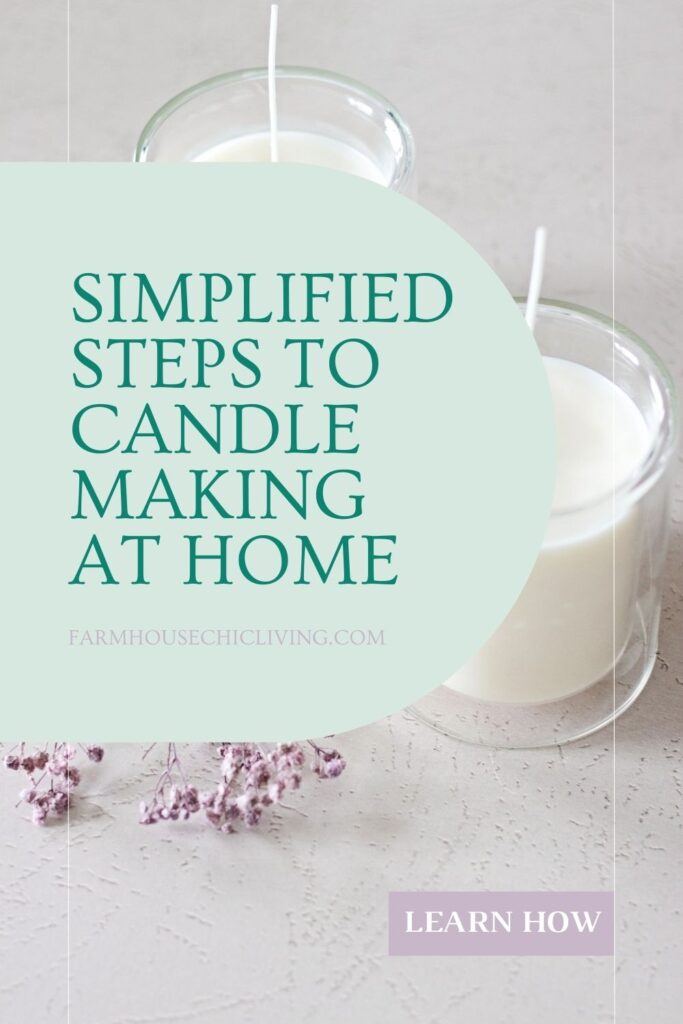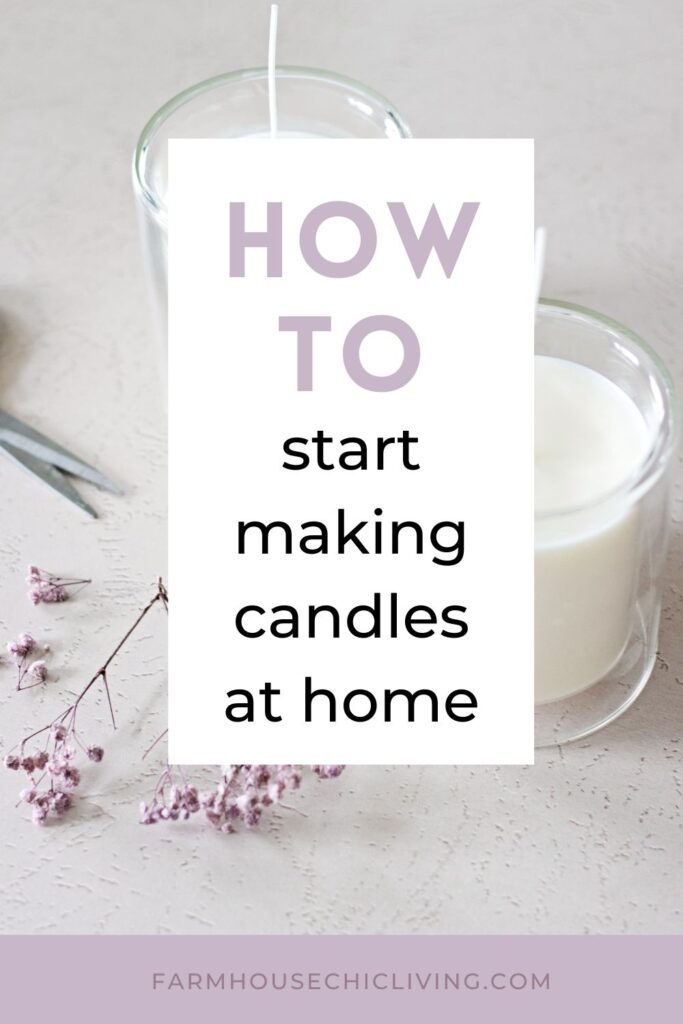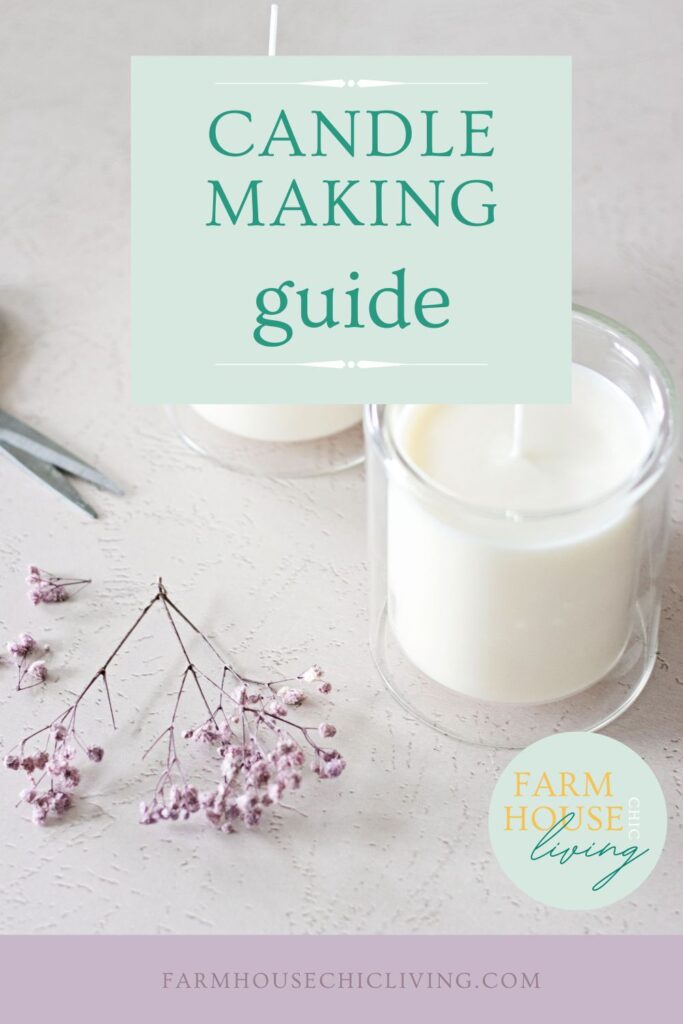DIY Candle Making
DIY Candle Making: A Quick Start Guide to Make Candles at Home
DIY Candle Making: In this quick start guide to homemade candles, you’ll be shocked at how simple it is with only 4 steps on how to make scented candles.
Do you enjoy having candlelight in your home too? It was the relaxing ambiance and comforting scents that sparked my interest in how to make candles. Spring, Summer, Fall, or Winter – no matter the season, I love making candles for our farmhouse.
And over the last five years, I have made a lot of candles.
I have found DIY candle making to be a creative and satisfying hobby. Unlike baking a pie or cake that you consume in a very short period of time, homemade candles can be enjoyed many times over several months or even years, depending on how often you light them.
If you’re considering learning how to create candles, I know you’ll enjoy this quick start guide to DIY candle making! I’m sharing my tips on how to make scented candles, along with a simplified 4-step approach to making candles at home.
This post contains some affiliate links for your convenience; please read the full disclosure policy.

Why buy candles when you can make them at home?
In this quick start guide to making candles, you’ll be shocked at how simple the process is. In fact, I’ve narrowed candle making down to just 4 steps!
And once you have the basics of candle making down, you can put your creative drive into full gear. You can work with different waxes, for example, soy and beeswax. As well as different wicks, such as natural cotton wicks and crackling wood wicks.
But the real fun begins with buying unique candle containers or repurposing containers in your home for candles like coffee mugs, ramekins, teacups, and mason jars.
And the most important and creative part about DIY candle making – is fragrance!
Today in the U.S., more than 75 percent of candles sold are scented. Meaning no matter how beautiful your candle containers are, people, choose candles based on scent. Which makes candle fragrance the most defining trait.

So, how do you make good-smelling candles?
In order to learn how to make scented candles, you must start by learning three key terms of candle making. When you put them to use, your homemade candles will pass the sniff test every time!
Cold Throw:
This candle making term describes the amount of fragrance emitted from a candle when it is not lit. I’m sure you may have noticed that many candles have a strong scent just resting in their containers.
(I know when I’m DIY candle making, our house fills with the fragrance I’m using, and it lasts for days without ever lighting a candle!)
Hot Throw:
You can guess what this term means if you read what cold throw means! It’s the strength of the fragrance emitted from a candle when burning.
Fragrance Load:
Sometimes referred to as scent load, this term is the percentage of the fragrance concentration. An 8 to 12 percent fragrance load is ideal. I’ve found using a 10% fragrance load suits my nose. And I keep the math easy for DIY candle making by using a fragrance load calculator to calculate how much scent I need for each batch.
Related To: Farmhouse Candle Making Supplies
What if You Want to Scent Candles with Essential Oils?
For essential oil DIY candle making, it is recommended to add half an ounce to one ounce of essential oils per one pound of wax.
For example, if you make a 4-ounce DIY candle with essential oils, you’ll need 2 to 4 ounces of essential oil. Which is much more than the average 5 or 15 ml essential oil bottles. And it takes a lot of plant matter to make one little bottle of essential oil!
On the other hand, if you make one 4-ounce candle with a natural fragrance oil, you’ll need less than half an ounce of fragrance for a 10% fragrance concentrate.
Did you know all-natural fragrance oils are composed of aromatic isolates from nature and essential oils? And just like essential oils, they have zero additives. Unlike typical fragrance oils, these do not contain parabens and phthalates. They are more affordable for DIY candle making than essential oils but are still perfect for creating a candle without synthetic ingredients.
Nonetheless, no matter what product you choose to scent your candles – just make sure you use these candle making tips to get the fragrance load right. Now, let’s get to the fun part, shall we?
DIY Candle Making Troubleshooting:
An unsteady candle flickering? If you light a candle and it flickers a lot, the wick is likely too long. So, just blow it out and trim it again. If a wick is too long, the flame with be too big and burn too hot.
A sinkhole in your candle? If you poured your candle wax before allowing it to cool, as described in step 3 below, then you may have sinkholes. This happens because the wax cooled much too quickly when you poured it into your candle container, which was room temperature. You can try using a heat gun to remove a skin hole or start all over again.
An uneven surface or bubbles? This common DIY candle making issue can quickly be remedied with a heat gun. On the low heat setting, hold the heat gun close to the area where there is a flaw. And move quickly back and forth over the surface of the candle. The wax will melt slightly and fix imperfections for a smooth finish.

4 Simplified Steps to DIY Candle Making
Follow my simplified four-step approach on how to make scented candles at home. With some practice, you’ll be a happy candle maker too!
Basic Candle Supplies:
- candle melting pitcher
- digital kitchen scale
- candle thermometer
- soy wax flakes
- candle scent
- cotton or wood candle wicks
How to Make Scented Candles:
1. Measure
The math to figure out how much candle wax you need is much easier than fragrance concentration calculating. It’s very close to an ounce per ounce. For example, to make four 4-ounce candles, you’ll need about 1 pound of wax. (But, because candle wax weighs more in volume than water – you’ll have a little extra, which is handy if you make a mistake.)
I find it’s best to use a kitchen scale for exact measurements. Although, I’ve heard others take a more hands-on approach by filling their candle container twice with wax and pouring it into a candle melting pitcher. Because there’s a lot of air space between soy wax flakes and often soy wax flakes melt to about half the volume of their solid form into a liquid.
2. Melt
I do not recommend melting candle wax in the microwave. It can melt very fast and get very hot running the wax. So make sure to melt wax in a candle melting pitcher. Place your pitcher filled with your measured wax inside a large saucepan filled with 2 inches of water.
Using the double boiler method, heat on medium to low heat, and don’t let the water get past a gentle simmer. The wax will begin to melt almost immediately. Use a heat-resistant silicone whisk or spatula to stir often.
It generally takes about 15 minutes to melt all the soy wax flakes.
3. Cool & Scent
After melting, remove the pitcher from heat immediately to avoid the wax becoming too hot. Then insert a candle thermometer and clip it to the inside of the pitcher. Allow the temperature of the wax to cool to between 125°F to 120°F before adding the candle scent.
If you add the scent before the wax cools down, you’ll essentially waste it as the scent will end up being weak.
Use the tips above to calculate the amount of scent you’ll need. After adding the scent, constantly stir slowly for 1 to 2 minutes for thorough blending.
4. Pour & Place Wicks
As the wax begins to melt, you can dip the metal tab of a cotton wick or metal clip of a wood wick into the wax. Then carefully center and adhere to the bottom of your candle container. Hold in place for a few seconds.
After a few minutes, the wax will harden and have a good hold on the container. You can do this before or after you add the candle scent. For cotton wicks, a centering device is quite handy for keeping each wick in place during the curing process.
TIP: Many pro candle makers also use a heat gun to warm up their candle containers before pouring the wax to avoid errors.
Next, gently pour your scented wax into each candle container. If you followed the candle making tips in step one, you should have the correct amount of wax.
Before trimming a wick, allow a candle to cool for 30 minutes to 1 hour. The wax should appear hard. Trim each wick to about ¼ an inch. Now, as tempting as it may be, do not light your homemade candle until it has cured for 72 hours.

DIY candle-making may seem intimidating at first, but once you have your candle supplies, step-by-step instructions, and a troubleshooting guide, it’s easy to do. Honestly, it really comes down to just melting the wax, adding scent, and pouring it into your containers.
Have you ever made homemade candles? Or is it something you are ready to try? Pin these easy DIY candle making techniques to your Pinterest DIY Board. Tag #farmhousechicliving on Instagram to share your candle-making results with us.
